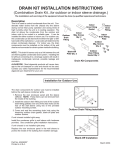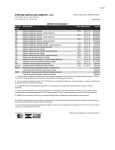Download A User's Guide to the Modified Demographic and Economic
Transcript
A User’s Guide to the Modified Demographic and Economic Model (MoDEM) Technical Paper Graeme Cuxson Shuyan Huo Jane Fry August 2007 The views expressed in this paper are those of the staff involved and do not necessarily reflect those of the Productivity Commission © COMMONWEALTH OF AUSTRALIA 2007 This work is subject to copyright. Apart from any use as permitted under the Copyright Act 1968, the work may be reproduced in whole or in part for study or training purposes, subject to the inclusion of an acknowledgment of the source. Reproduction for commercial use or sale requires prior written permission from the Attorney-General’s Department. Requests and inquiries concerning reproduction and rights should be addressed to the Commonwealth Copyright Administration, Attorney-General’s Department, Robert Garran Offices, National Circuit, Canberra ACT 2600. This publication is available in PDF format from the Productivity Commission website at www.pc.gov.au. If you require part or all of this publication in a different format, please contact Media and Publications (see below). Publications Inquiries: Media and Publications Productivity Commission Locked Bag 2 Collins Street East Melbourne VIC 8003 Tel: Fax: Email: (03) 9653 2244 (03) 9653 2303 [email protected] General Inquiries: Tel: (03) 9653 2100 or (02) 6240 3200 An appropriate citation for this paper is: Cuxson, G., Huo, S. and Fry, J. 2007, A User’s Guide to the Modified Demographic and Economic Model, Productivity Commission Technical Paper, Melbourne. The Productivity Commission The Productivity Commission, an independent agency, is the Australian Government’s principal review and advisory body on microeconomic policy and regulation. It conducts public inquiries and research into a broad range of economic and social issues affecting the welfare of Australians. The Commission’s independence is underpinned by an Act of Parliament. Its processes and outputs are open to public scrutiny and are driven by consideration for the wellbeing of the community as a whole. Information on the Productivity Commission, its publications and its current work program can be found on the World Wide Web at www.pc.gov.au or by contacting Media and Publications on (03) 9653 2244. Contents Acknowledgments V Disclaimer 1 VI A user’s guide to the Modified Demographic and Economic Model 1 How MoDEM works 2 How to use MoDEM 3 A step-by-step guide to implementing a hypothetical scenario in the main model 4 Frequently asked questions 10 14 A Theory and structure of MoDEM A.1 Population projections A.2 Labour supply projections 19 19 20 B Explaining the equations in the user-defined shocks B.1 The equations 23 23 References 1 2 3 27 FIGURES 1 2 3 4 5 A.1 A.2 The three modules of MoDEM Primary options in MoDEM Secondary options for life expectancy Secondary options in MoDEM Managing user-defined shocks Population projection framework — stocks and flows Labour supply projection framework — inputs and outputs CONTENTS 2 3 4 5 7 20 21 III TABLES 1 2 3 B.1 Key results under the hypothetical scenario, 2051 List of data sheets in the main model Parameters and options in MoDEM Key to equation variables 13 17 18 23 ATTACHMENTS 1 2 3 4 5 6 IV ‘Demographic projections’, Technical Paper 1 of Economic Implications of an Ageing Australia, Productivity Commission Research Report, 2005, Canberra. ‘Ageing and labour markets’, Chapter 3 of Economic Implications of an Ageing Australia, Productivity Commission Research Report, 2005, Canberra. ‘Cohort analysis’, Technical Paper 3 of Economic Implications of an Ageing Australia, Productivity Commission Research Report, 2005, Canberra. ‘Productivity and ageing’, Chapter 4 of Economic Implications of an Ageing Australia, Productivity Commission Research Report, 2005, Canberra. ‘Consolidating the effects of human capital reform’, Chapter 14 of Potential Benefits of the National Reform Agenda, Productivity Commission Report to the Council of Australian Governments, 2007, Canberra. ‘The productivity of outsiders’, Appendix E of Men Not at Work: An Analysis of Men Outside the Labour Force, Productivity Commission Staff Working Paper, 2007, Canberra. CONTENTS Acknowledgments The authors wish to thank Dr Jeromey Temple, Research Fellow at the Demography and Sociology Program, Australian National University, and Dr Ralph Lattimore, Productivity Commission, for their helpful comments on an earlier version of this paper. Comments from Patrick Jomini of the Productivity Commission are likewise gratefully acknowledged. The authors also wish to thank those Commission staff who have contributed to the development of the model, beginning with the report on Economic Implications of an Ageing Australia, and continuing with the research paper on Potential Benefits of the National Reform Agenda. Particular credit must go to Ralph Lattimore, who designed and built the first version of the model. ACKNOWLEDGMENTS V Disclaimer Disclaimer of liability and conditions of use 1. To the extent permitted by law: (a) the Commonwealth of Australia and the Productivity Commission (the Agencies) give no warranty of any type, either express or implied, for MoDEM (the Program), and any other material supplied with the Program; and (b) the entire risk of loss, damage or unsatisfactory performance of the Program (no matter how arising, including as a result of negligence on behalf of the Agencies) rests with the user (the User). In no event will the Agencies be liable for damages, including any general, special, incidental or consequential damages, arising out of the installation of the Program, any attempt to install the Program, the use of the Program, the inability to use the Program, the use of data embodied in, or obtained from, the Program or the use of any documentation or other material accompanying the Program. 2. The numerical data and formulas contained in the Program are provided solely for the purpose of illustrating the modelling framework for projecting possible outcomes under different demographic and economic scenarios. The Agencies give no warranty and make no representation as to the accuracy, reliability, timeliness or other features of any data contained in the Program or data obtained from using the Program. In particular: (a) the User should rely on the User’s own inquiries as to the accuracy and relevance of the data incorporated into or applicable to the Program; (b) the User should not use the Program as the basis for making any decision or embarking on any course of action; and (c) the data contained in the Program and the output of the Program should not be regarded as representative of any current data or forecasts of what will happen under a given set of demographic and economic conditions. 3. The Program is based on input (parameters and projections) from data published by the Australian Bureau of Statistics. From time to time the ABS may publish updated data which may be relevant to the Program. Users should rely on their own inquiries in relation to the accuracy and relevance of any available data and its appropriateness for updating the Program. The Agencies accept no responsibility for errors in the input data, the lack of currency of the input data, any problems experienced by the user in updating or attempting to update the input data, or the results obtained from running the Program using the updated data. 4. If you have obtained this Program otherwise than by downloading it from the Productivity Commission’s website, the Program may have been modified by a previous user. The Agencies accept no liability in relation to modifications made by any user. (Continued next page) VI DISCLAIMER Disclaimer of liability and conditions of use (continued) 5. The intellectual property in this Program is and remains the property of the Agencies. 6. The Program is made available to Users for their own use and may be provided or redisseminated by them to another party. The User who re-disseminates the Program should include the disclaimer and conditions of use in its current form with the Program, and identify any modifications made by the User to the Program and Documentation. 7. The User may modify the Program. However, the Productivity Commission would appreciate being informed of any modifications made by the User and being offered the opportunity to add any extra data and modifications to its own version of the Program. When making modifications of the Program available to the Commission, please also identify who created the material contained in the modifications. 8. Users who have obtained the Program from a person other than the Productivity Commission are still bound by these conditions of use. The Agencies recommend that Users go to the Productivity Commission’s website at www.pc.gov.au to download the original version of the Program. DISCLAIMER VII A user’s guide to the Modified Demographic and Economic Model A demographic model was created for the Commission’s report on Economic Implications of an Ageing Australia (PC 2005). The model was modified for the report on Potential Benefits of the National Reform Agenda (PC 2007). This Modified Demographic and Economic Model (MoDEM) is used to generate population, labour supply and GDP projections1 under different socioeconomic scenarios. This user’s guide to MoDEM is structured as follows. Section 1 describes the structure and components of the model. Section 2 explains how to use the model. Section 3 provides a step-by-step guide to implementing a hypothetical scenario. Section 4 answers some ‘frequently asked questions’. Further information on MoDEM can be found in the following documents attached to this user’s guide: • Appendix A details the structure and theory of the model. • Appendix B explains complex formulas in the model. • Attachment 1 describes assumptions, methods and data used. • Attachment 2 discusses likely trends in labour supply parameters (participation rates, unemployment rates and hours worked). • Attachment 3 explains the cohort analysis used for the labour supply projections. • Attachment 4 outlines the assumptions for future labour productivity growth. • Attachment 5 provides an example of how the model was used to estimate the potential effects of the National Reform Agenda. • Attachment 6 explores problems in projecting the labour market performance of ‘outsiders’. 1 As the labour market is not directly modelled in MoDEM, the model uses assumptions about labour supply and productivity parameters to guide the projections. The assumptions provide plausible (but nonetheless conditional) outcomes that might arise from a full modelling of the labour market. A USER’S GUIDE TO MoDEM 1 1 How MoDEM works MoDEM consists of three parts: (1) a demographic projection module; (2) a labour projection module; (3) an optional module to disaggregate national projections to the state and territory level (figure 1). MoDEM is used to calculate population, labour supply and GDP projections under different socioeconomic assumptions. The key results include population size, dependency ratios, aggregate participation rates, GDP and GDP per capita. Two sets of projections can be compared to evaluate the effects of a change in assumptions. Figure 1 The three modules of MoDEM Discount rates for 'outsiders'* Labour module Population module (Trends in mortality, fertility and migration) Labour supply (Trends in participation, employment, average hours and productivity) State and Territory disaggregation module (STDM) (State/Territory population projections) Incremental changes Population size and dependency ratios GDP and labour supply measures Labour supply measures * Outsiders are defined as persons who were not in the labour force in the baseline, but enter the labour force as a result of a change in labour supply parameters. In the ‘user-defined shocks’ extension, there is also an option for treating workers who were previously unemployed in the baseline as outsiders (see section 4, Q.4). Projections generated with the model are conditional, based on assumptions about demography and labour supply. They are not forecasts. 2 POTENTIAL BENEFITS OF THE NATIONAL REFORM AGENDA 2 How to use MoDEM 2.1 The structure of the excel file The main model consists of the population and labour modules. It is contained in an excel file (MoDEM 01.xls), which consists of 49 data sheets. This includes 30 input data sheets in grey and blue, which normally do not require users’ attention (table 2 provides a list). Other worksheets are grouped by tab colour: • The ‘Introduction’ sheet in yellow guides you around the file. • The yellow ‘Scenarios’ sheet sets out most options of the main model. • Projected population results and dependency ratios are located on the red sheets. • Projections for births, deaths and migration are on the green sheets. • Economic results are found on either the bright green ‘GDP’ sheet, or, if your scenario includes ‘user-defined shocks’ to labour supply, the ‘GDP-UDS’ sheet (see section 2.3 for an explanation of user-defined shocks). 2.2 Options available for creating scenarios There are two categories of options for creating scenarios: • Primary options control patterns in fertility, migration, mortality (or life expectancy) and labour force participation. These options are located in the top left of the ‘Scenarios’ sheet (figure 2). • Secondary options build more details into, or refine, the primary options. For example, there are a number of secondary options for life expectancy (figure 3). Table 3 of this user’s guide lists the parameters and their available options. Figure 2 Primary options in MoDEM Source: MoDEM. A USER’S GUIDE TO MoDEM 3 Figure 3 Secondary options for life expectancya a The ‘Booth’ scenarios were estimated by Heather Booth from the Australian National University (commissioned by the Productivity Commission) using the Lee-Carter method (see attachment 1 for details). Source: MoDEM. 2.3 The baseline scenario MoDEM generates projections for a baseline and an alternative scenario. Having both in the model allows users to compare the two scenarios. The ‘medium’ or default baseline scenario is described in section 4. Users can define their own baseline scenario by setting up a new scenario (see section 2.4) and then pressing the ‘Set baseline values’ button. 2.4 Setting up alternative scenarios Most options for setting up a scenario are controlled on the ‘Scenarios’ sheet. Population options • Select primary options for life expectancy (LE), net overseas migration (NOM), and fertility rates (Fert) on the ‘Scenarios’ sheet (figure 2). • Select secondary options for high or low life expectancy in table 1 (figure 3), and for NOM and Fert in table 2 (figure 4) on the ‘Scenarios’ sheet. 4 POTENTIAL BENEFITS OF THE NATIONAL REFORM AGENDA • Check results for population projections and dependency ratios on the corresponding red sheets. The ‘Scenarios’ sheet provides quick graphical summaries of these results. Figure 4 Secondary options in MoDEM Source: MoDEM. A USER’S GUIDE TO MoDEM 5 Labour options • Primary options – Select an option for participation rates on the ‘Scenarios’ sheet (figure 2).2 – Specify an aggregate productivity growth rate in cell B4 on the ‘GDP’ sheet. The default annual productivity growth rate is 1.75 per cent. • Secondary options – You can change the transition time for the ‘OECD 80%’ or ‘Female Converge’ options in table 2 on the ‘Scenarios’ sheet (figure 4). The default transition time is 41 years (see section 4, Q.7 for an explanation). – You can implement ‘relative productivity margins’ in table 2 on the ‘Scenarios’ sheet (figure 4). This allows productivity to vary by age (see section 4, Q.3 for details). – You can also switch on ‘insider versus outsider characteristics’ in table 2 on the ‘Scenarios’ sheet (figure 4). This applies a discount to labour outcomes for additional participants (see section 4, Q.4 for an explanation of ‘outsider discounts’). Default discount rates are in cells D5:D8 on the ‘GDP’ sheet. You can set your own discount rates by changing cells C5:C8. • Check results on the ‘GDP’ sheet. This result sheet contains the key economic projections for your alternative scenario. It also provides the deviation between the baseline and alternative scenarios for selected results. The ‘user-defined shocks’ (UDS) extension The UDS extension provides flexibility in modelling labour supply scenarios.3 It allows users to set their own shocks — as changes relative to the baseline scenario — for participation rates, unemployment rates, average hours worked and productivity. You can specify shocks by age, sex and projection year. For example, you could increase participation rates by 10 percentage points for females aged over 50, implemented between 2020 and 2030. 2 There are no built-in alternative scenarios for unemployment or average hours per worker. 3 Labour supply parameters might change as a result of changes in their determinants, such as health, education and work incentives. Furthermore, changes in demographic assumptions could change labour supply. An increase in fertility might reduce labour force participation of females aged 20–40, for example. MoDEM does not account for these effects endogenously. However, the UDS extension allows you to include these effects exogenously. 6 POTENTIAL BENEFITS OF THE NATIONAL REFORM AGENDA User-defined shocks are managed in table 3 on the ‘Scenarios’ sheet (figure 5). The actual shock values are entered on up to three pink sheets, namely ‘Stream one’, ‘Stream two’ and ‘Stream three’. This allows users to include separate effects for up to three sources. To implement user-defined shocks to labour supply parameters: • First, switch on the relevant parameters that you want to shock in table 3 on the ‘Scenarios’ sheet (figure 5). Figure 5 Managing user-defined shocks Source: MoDEM. • Second, enter your shocks for the relevant parameters in up to three streams (on the three pink sheets). These shocks must be incremental values or changes relative to the default baseline scenario.4 It is important to use the correct units and signs for the shocks. 4 User-defined shocks are added to the ‘Base-case participation rate’ sheet to get participation rates for the alternative scenario. If participation rates are changed in a new baseline scenario, increments in the user-defined shock extension might also have to be adjusted to get the correct participation rates for the alternative scenario. A USER’S GUIDE TO MoDEM 7 • Third, specify a multiplier (or weight) in cell I1 on the pink ‘UDS increments’ sheet to aggregate the shocks from the active streams. This allows the total effect to be less than or greater than the sum of the active streams. The default value for this option is one. • Finally, use the ‘insider versus outsider characteristics’ option to further refine the shocks. This applies a discount to labour outcomes for outsiders (see section 4, Q.4 for an explanation). The default discount rates are given in cells D5:D8 on the ‘GDP-UDS’ sheet. You can set your own discount rates by changing cells C5:C8. • The ‘GDP-UDS’ sheet contains the key economic projections for your UDS scenario. It also provides deviations between the baseline scenario and the UDS scenario for selected results. 2.5 Examining economic results There are three result sheets in MoDEM. They are the ‘GDP-baseline’, ‘GDP’ and ‘GDP-UDS’ sheets. On all three sheets, highlighted cells in rows 164 to 186 contain key labour supply and economic projections. Rows 196 to 215 contain summaries of the projected labour outcomes. Having three separate result sheets enables users to isolate the effects of different scenarios: • The ‘GDP-baseline’ sheet contains results for the baseline scenario. • The ‘GDP’ sheet reflects your choices about population and labour supply parameters, but excludes the effect of any user-defined shocks. • The ‘GDP-UDS’ sheet reflects all of your choices about the population and labour supply parameters, including the user-defined shocks. • If you did not specify any user-defined shocks, the projections on the ‘GDP’ and ‘GDP-UDS’ sheets are typically the same (unless you have different productivity growth rates or outsider discounts in cells B3:B8 on the two sheets). • Deviations in the economic results, relative to the ‘GDP-baseline’ sheet, are presented in rows 216 to 236 on the ‘GDP’ and ‘GDP-UDS’ sheets. • Deviations in the economic results, relative to the ‘GDP’ sheet, are presented in rows 240 to 258 on the ‘GDP-UDS’ sheet. These numbers show the direct effect of any user-defined shocks to labour supply. 8 POTENTIAL BENEFITS OF THE NATIONAL REFORM AGENDA 2.6 Using the optional State and Territory Disaggregation Module The State and Territory Disaggregation Module (STDM) disaggregates the national labour supply results on the GDP-UDS sheet to State and Territory levels. This module does not require data input by users. The results are generated automatically using links to the main model. However, the STDM is fairly limited. The summary results are only calculated for a specific year (currently 2030). The ‘baseline’ is currently fixed as the default or ‘medium’ scenario (described in section 4). Nevertheless, advanced users can use it as a starting point — all of the necessary data is there to calculate results for any projection year. The STDM applies national age–sex specific labour supply parameters to the projected population profile of each State and Territory. This framework assumes that the age–sex specific labour market parameters (for example, participation rates of females aged 20–24) are the same for each State and Territory. Therefore, the disaggregation only takes account of differences in the projected age–sex structure of each State and Territory. Analysis suggests this is a good approximation for most jurisdictions, but overstates Tasmania’s participation rate and understates the ACT’s (PC 2007, box 14.2, reproduced in attachment 6). To use the STDM: • Open (download) the STDM excel file (STDM 01.xls), which is linked to the main model (on the ‘AUS UDS’ and ‘UDS labour’ sheets). • At the initial prompt, press the ‘update values’ button to automatically update the STDM sheets. • Check that the links on the ‘AUS UDS’ and ‘UDS labour’ sheets refer to the correct version of the main model. If you have created different versions of the main model or saved it with a different filename, you will need to change the link so it points to the appropriate file. – Change the link using the Excel menu (edit/links/change source) or shortcut (ALT+E,K,N). There might be a short delay while the link adjusts. – Update values in the file by using the Excel menu (edit/links/update values) or shortcut (ALT+E,K,U). • When the link is correct and the cell values have been updated, examine your results on the black ‘Summary’ sheet in the STDM. • More information on the assumptions in the STDM is available on the yellow ‘Introduction’ sheet of the STDM. A USER’S GUIDE TO MoDEM 9 3 A step-by-step guide to implementing a hypothetical scenario in the main model This section provides a step-by-step guide on how to implement a hypothetical scenario. It shows how to change some of the default settings in the model. The scenario also includes user-defined shocks to participation rates, unemployment rates and productivity. 3.1 Defining a hypothetical scenario Assume the Government introduces policy changes that increase immigration and fertility, and improve education and health. The improved education and health outcomes impact on participation rates, unemployment and productivity. The effects on labour outcomes come about slowly, and vary according to age and sex. For this scenario, assume selected demographic parameters change as follows:5 • Life expectancy increases in a pattern represented by the ‘Booth HIGH’ option. • Fertility increases to a total fertility rate of 1.9 in the first 5 years and remains constant at that level thereafter. • Net overseas migration (NOM) is set as a fixed percentage of the population, 0.7 per cent. This change in migration is phased in over 20 years, from the initial NOM of 115 000 in the base year (0.57 per cent of the base year population). Improvements in education and health are assumed to affect labour supply as follows: • Health improvements, from 2010 (that is, six years after the base year): – increase participation rates by 1 percentage point for persons aged under 50, and by 2 percentage points for persons aged over 50 – reduce unemployment by 0.2 percentage points for all persons – • increase productivity by 1 per cent for persons aged under 50, and by 2 per cent for persons aged over 50. Education improvements increase the number of persons completing secondary school and going on to university. This, in turn: – reduces workforce participation rates for 15–24 year olds by 5 percentage points every year after 2010 5 In reality, these types of changes would be informed by additional information or research. 10 POTENTIAL BENEFITS OF THE NATIONAL REFORM AGENDA – increases workforce participation rates for persons aged 25–54 after 2020 (2 percentage points for males and 5 percentage points for females) – reduces unemployment rates by 0.5 percentage points and increases productivity by 1 per cent for those aged under 55, from 2020 onwards. • In this scenario, all additional workers from increased participation rates and decreased unemployment rates are treated as outsiders (see section 4, Q.7). 3.2 Implementing the scenario This section provides modelling instructions as a sequence of steps. It is best understood by having the excel file open and working through each step. Setting up the baseline scenario Before implementing the hypothetical scenario, you will need to reset the baseline scenario to the default demographic and labour supply settings: • Ensure primary options on the ‘Scenarios’ sheet are set to ‘Medium’. • Press the ‘Set baseline values’ button near cell G50 on the ‘Scenarios’ sheet. • The results for the baseline scenario are ‘saved’ in the ‘GDP-baseline’ sheet. Selecting demographic options for the alternative scenario • Life expectancy: On the ‘Scenarios’ sheet, click on ‘High LE’. Due to the size of the file, it might take a few seconds until ‘HIGH’ appears in cell C2. Now, change the secondary mortality scenario in Table 1 by clicking on ‘Booth HIGH’. Cell B39 will change to ‘BOOTH_HIGH’. • Fertility: Still on the ‘Scenarios’ sheet, click on the ‘High Fert’ button (cell E2 will change to ‘HIGH’). In table 2, change cell C88 to 1.9 and cell E88 to 5. • NOM: On the ‘Scenarios’ sheet, click on the ‘% of population NOM’ button. Cell D2 will change to ‘Percent_NOM’. Change cell D3 to 0.7. Then, go to the grey ‘Percent_NOM’ sheet and change cell P3 to 20 (years). Implementing user-defined shocks to labour supply parameters In this scenario, there are two ‘streams’ of shocks — health and education: A USER’S GUIDE TO MoDEM 11 • Switch on participation, unemployment and productivity options for Streams one and two on the ‘Scenarios’ sheet. That is, change values for these three parameters to 1 in table 3 (rows 109-125) as shown in figure 5 above. • Switch on ‘participation outsiders’ and ‘unemployment outsiders’ on the ‘Scenarios’ sheet. That is, set cells D129 and D130 to 1. By activating both cells, the model treats all additional workers as outsiders. • Enter outsider discounts for productivity, employment, average hours worked and (propensity for) full-time work on the green ‘GDP-UDS’ sheet, by changing cells C5:C8 to 90, 95, 90 and 80 per cent (do not change column B5:B8). These are higher than the defaults. This scenario assumes that health and education improvements will enhance the characteristics of the outsiders. • Enter shocks from health improvements in the ‘Stream one’ sheet: – Enter an increase in participation rates of persons aged under 50 by 1 percentage point, and those aged over 50 by 2 percentage points — change cells H6:AY12 and H20:AY26 to 1%, then change cells H13:AY17 and H27:AY31 to 2%. – Reduce unemployment by 0.2 percentage points for all persons by entering ‘–0.2%’ in cells H36:AY47 and H50:AY61. – Increase productivity by 1 per cent for persons aged under 50, and by 2 per cent for persons aged over 50 — change cells H156:AY162 and H170:AY176 to 1.01, then H163:AY167 and H177:AY181 to 1.02. • Enter shocks from education improvements in the ‘Stream two’ sheet: – Reduce participation for 15–24 year olds by 5 percentage points every year after 2010 — change cells H6:AY7 and H20:AY21 to ‘–5%’. – Increase participation rates for persons aged 25–54 after 2020 (2 percentage points for males and 5 percentage points for females) — change cells R8:AY13 to 2% and R22:AY27 to 5%. – Reduce unemployment rates after 2010 by 0.5 percentage points for 15–54 year olds — change cells R36:AY43 and R50:AY57 to ‘–0.5%’. – Increase productivity by 1 per cent for everyone aged under 55 from 2020 onwards — change cells R163:AY163 and R177:AY177 to 1.01 • 12 Enter a multiplier on the pink ‘Total UDS increments’ sheet, by changing cell I1 to 1.1. The total effect of the shocks is now 10 per cent bigger than the sum of the shocks from the two streams. This assumes that the health and education reforms will complement each other. POTENTIAL BENEFITS OF THE NATIONAL REFORM AGENDA 3.3 Results and interpretation Selected results for the hypothetical scenario are given in table 1. These figures are for the year 2051 (the last year of the projection). The projections in the ‘GDP-UDS’ sheet reflect all of the assumptions about the population and labour supply parameters, including the user-defined shocks. The ‘GDP’ sheet only reflects the demographic changes (section 2.4). Table 1 Key results under the hypothetical scenario, 2051 Variable Total population Value Cell location 36 460 305 Pop_estimate!AW319 Dependency ratios – Old 45.51 Dependency!AV4 – Young 29.08 Dependency!AV6 $82 752 GDP-UDS!AW166 GDP per capita (2002-03 prices) Change in the aggregate participation rate – Total effect including demographic changes 1.64% GDP-UDS!AW221 – Effect of the user-defined shocks only 2.54% GDP-UDS!AW243 – Effect of the demographic changes only –0.9% GDP!AW221 Total change in the aggregate unemployment rate –0.61% GDP-UDS!AW226 Total change in average hours per worker –0.39% GDP-UDS!AW226 1.92% GDP-UDS!AW236 Total change in productivity Source: MoDEM simulations under the hypothetical scenario. Why did ‘average hours per worker’ change even though it was not ‘shocked’? Two factors determine average hours per worker: the age–sex composition of workers and the average hours worked by each age–sex group. We did not shock the latter. However, two things changed the former. First, the demographic changes (higher life expectancy, fertility and NOM) caused a change in the age–sex profile of the population. Second, because the participation rate shocks were different for different age–sex groups, the profile of the workers also changed. Similarly, why did the productivity of female workers (1.79 per cent) increase less than that of male workers (2.01 per cent), even though the productivity shocks were the same? The answer lies in the 10 per cent productivity discount for additional workers. There are more additional female workers than additional male workers — the participation rate shock in the education stream was higher for women (5 percentage points) than for men (2 percentage points). More female outsiders, A USER’S GUIDE TO MoDEM 13 combined with the 10 per cent productivity discount, leads to a smaller increase in productivity for women. To confirm this, switch off the insider versus outsider discounts. Without the discounts, the increases in productivity for women (2.34 per cent) and men (2.33 per cent) are almost identical. 4 Frequently asked questions Q.1 What are the main parameters required in MoDEM? Table 2 in this user’s guide provides a list of parameters and options in MoDEM. Appendix A explains the theoretical structure of the model. Further information on the demographic data used for these parameters is provided in attachment 1. Q.2 What are the assumptions made for the key parameters in the default baseline scenario?6 The ‘medium’ baseline scenario consists of the following assumptions for life expectancy, net overseas migration and fertility: • Male and female life expectancy is 84.2 and 87.7 years respectively by 2050-51. This adopts the mortality rates from the ABS B series from 2003. • The total fertility rate increases marginally from 1.76 in 2004, stabilising at 1.80 by 2014. • Net overseas migration is fixed at 115 000 per year throughout the projection. • The age–sex structure of NOM is fixed, based on ABS estimates (attachment 1). The baseline labour supply parameters were estimated using cohort analysis methods, based on recent trends (attachment 3). • Men’s participation rates are projected to decline for most age groups. Women’s participation rates are projected to increase for every age group. • Unemployment rates are assumed to fall slightly for most age–sex groups. • A trend towards part-time work leads to a small decline in projected average hours worked by men in each age group. However, average hours worked by women in each age group are projected to remain fairly stable. 6 MoDEM was developed using 2003 and 2004 data. More recent data reveal differences from some of the projected trends. For example, fertility rates have increased sharply, compared with the slow increase projected in the baseline. Also, the prior decline in participation rates of older males has reversed in recent years, compared with the continued decline projected in the model. 14 POTENTIAL BENEFITS OF THE NATIONAL REFORM AGENDA Q.3 How is productivity treated in MoDEM? In the baseline, productivity consists of a positive trend in labour productivity based on the average trend over the past 30 years — 1.75 per cent annually. This includes multi-factor productivity growth and capital deepening (attachment 4). Users can change the annual rate in cell B3 on the ‘GDP’ and ‘GDP-UDS’ sheets. Users can customise the productivity trend through the following built-in options: • On the ‘GDP’ sheet: – Relative productivity margins – Insider versus outsider characteristics. • On the ‘GDP-UDS’ sheet: – User-defined shocks to productivity – Insider versus outsider characteristics. Relative productivity margins account for potential differences in the productivity of workers across age–sex groups. This reflects the view that an individual’s productivity rises until some middle-age peak, after which it begins to decline (see attachment 4 for a detailed discussion). There is no explicit equivalent in the UDS extension. However, users can still implement a profile of productivity by age and sex. Enter the productivity profile as a productivity shifter in one of the three streams (rows 157 to 182). Using this approach, the productivity profile can also change over time. Q.4 What are insiders and outsiders? Insiders are defined as persons in the labour force in the baseline scenario. Outsiders are persons who are not in the labour force in the baseline scenario, but enter the labour force as a result of changes in labour supply parameters. Additional workers as a result of demographic changes are not treated as outsiders. In the user-defined shocks extension, there is an additional option to treat persons who are unemployed in the baseline, but employed in the alternative scenario, as outsiders. This might be useful if you want to shock unemployment rates. A USER’S GUIDE TO MoDEM 15 Q.5 How did the Productivity Commission come up with the outsider discounts? Estimating outsider discounts is difficult. Persons outside the labour force generally have different characteristics compared with current workers — in terms of observable characteristics such as skills and health, and unobservable characteristics such as motivation and attitude (attachment 6). On average, outsiders are likely to have lower probability of employment, lower propensity for full-time work, lower average hours worked and lower average productivity. The outsider discounts in PC (2005) were based on judgments informed by the literature. The discounts in PC (2007) were adjusted to reflect the specific group of outsiders considered in that study. Q.6 How come the ‘unemployment’ discount does not apply to persons aged over 65? Persons aged 65 years and over tend to either have a job, or are in retirement. Unemployment is rare. This might reflect the availability of the aged pension, which is more generous and has less obligations than unemployment benefits. Q.7 What do ‘OECD 80%’ and ‘Female Converge’ mean? The ‘OECD 80%’ option assumes that cohort-specific participation rates in Australia eventually reach the 80th percentile participation rates of OECD countries, unless they are projected to be higher in Australia. In other words, MoDEM chooses the higher of the two projected participation rates for each age–sex group. The default transition time is 41 years. The ‘Female Converge’ option assumes that the participation rate of females aged over 60 eventually equals that of men of the same age. This might reflect the current policy to increase the female retirement age (for the aged pension) until it equals the male retirement age. The default transition time is 41 years. 16 POTENTIAL BENEFITS OF THE NATIONAL REFORM AGENDA Table 2 List of data sheets in the main model Sheet name Colour Role Disclaimer Introduction Scenario Dependency Pop_estimate Pyramids Births Deaths Survivors Migrants Stream one Stream two Stream three UDS increments H_LE M_LE L_LE BOOTH_HIGH BOOTH_MED BOOTH_LOW Chart mortality rates PC_HIGH PC_LOW ABS_HIGH Percent_NOM H_NOM M_NOM L_NOM Age share of NOM base yr TFR Chart of ASFRs H_Fert M_Fert L_Fert POPMA Base-case participation rate OECD 80% Female convergence Incremental participation Unemployment rate Part-time work Av hours FT Av hours PT CPOP ratio Intermediate GDP-baseline GDP GDP-UDS GDP Summary Yellow Yellow Yellow Red Red Red Dark green Dark green Dark green Dark green Pink Pink Pink Bright pink Grey Grey Grey Grey Grey Grey Grey Grey Grey Grey Grey Grey Grey Grey Grey Grey Grey Grey Grey Grey Blue Blue Disclaimer of liability and conditions of use Provides a guide to the rest of the file Main control page for selecting scenarios and options Calculates dependency ratios Year by year projections of population by age and sex Calculates population pyramids for selected years Calculates births from Pop and chosen fertility scenario Calculates deaths from Pop and chosen LE scenario Calculates the end of year population except migrants Calculates surviving migrants from NOM & LE scenarios Parameter sheet for entering UDS Parameter sheet for entering UDS Parameter sheet for entering UDS Selects the active UDS out of previous 3 sheets Selects high life expectancy scenario from given options Med life expectancy scenario from the Ageing report (PC 2005) Selects low life expectancy scenario from given options High life expectancy parameters from Booth Medium life expectancy parameters from Booth Low life expectancy parameters from Booth A chart to visually compare life expectancy options High life expectancy scenario from the Ageing report (PC 2005) Low life expectancy scenario from the Ageing report (PC 2005) ABS high life expectancy scenario Calculates NOM by age from Pop size and age shares Calculates NOM by age from scenario and age shares Calculates NOM by age from scenario and age shares Calculates NOM by age from scenario and age shares Parameter sheet with the age shares of NOM by year Contains the initial year TFR (currently 2003 data) A chart to visually compare fertility scenarios Calculates high fertility based on specified final TFR Calculates medium fertility based on specified final TFR Calculates low fertility based on specified final TFR Takes a moving average of the population projections Parameter sheet of base-case participation rates Blue Blue Blue Blue Blue Blue Blue Blue Blue Bright green Bright green Bright green Green Participation rate scenario based on OECD 80% target Scenario of female participation rates converging to male rates Implements the selected participation rate scenario Parameter sheet of default unemployment rates Parameter sheet of default part-time shares Parameter sheet of default full-time average hours Parameter sheet of default part-time average hours Parameter sheet adjusting population to civilian population Calculates civilian working-age population and UDS increments Contains key economic results for the baseline scenario Contains key economic results for the chosen scenario Contains key economic results including user-defined shocks Summarises past and projected GDP estimates ASFR Age-specific fertility rate; LE Life expectancy; NOM Net overseas migration; TFR Total fertility rate; UDS User-defined shocks. A USER’S GUIDE TO MoDEM 17 Table 3 Parameters and options in MoDEM Module Parameters Primary options Secondary options Population Life expectancy High LE • Default (PC HIGH) values in 2051 — for males 92.2 (yrs) and 95 (yrs) for females • Customised LE for males and females (LE) • Booth MEDIUM • Booth HIGH • ABS HIGH Medium LE • Default only (ABS) Low LE • Default (PC LOW) values in 2051 — for males 83 (yrs) and 86 (yrs) for females • Customised LE for males and female • Booth LOW High NOM Medium NOM Low NOM • Default NOM value and transition time (10 yrs) from original level (115 000) • Customised values for NOM and transition time (yrs) NOM as % of population • Default NOM as % of the population (0.572%) and transition time (10 yrs) from original level (115 000) • Customised % of the population and transition time Fertility (Fert) High Fert Medium Fert Low Fert • Default Fert rate and transition time (10 yrs) from initial fertility levels (1.76) • Customised Fert rate and transition time (yrs) from initial fertility levels (1.76) Participation rates Base case • Default as in Ageing report (PC 2005) OECD 80% • Default: OECD 80%a reached in 41 yrs • Customised years to reach OECD 80% Female Converge • Default: female convergence (gap made up after 41 years)a Net overseas migration (NOM) Labour supply • Customised years to reach convergence Unemployment rates Default only Average hours per worker Default only Productivity Default 1.75% per year Customised annual rate • Relative productivity marginsb User-defined shocks (incremental values) Customised multiplier • Insider versus outsider characteristicsc – Participation outsiders – Unemployment outsiders User-defined Participation shocks Unemployment Hours Productivity • Insider versus outsider characteristicsc a See section 4, Q.7 for an explanation of this option. b See section 4, Q.3 for an explanation of ‘Relative productivity margins’. c See section 4, Q.4 and Q.5 for an explanation of ‘Insiders versus outsider characteristics’. 18 POTENTIAL BENEFITS OF THE NATIONAL REFORM AGENDA A Theory and structure of MoDEM This appendix provides an introduction to the theory and structure of the Modified Demographic and Economic Model (MoDEM). Technical papers 1 and 3 from Economic Implications of an Ageing Australia (PC 2005) provide more detail and are reproduced as attachments 1 and 3 to this paper. This appendix has two sections: • The first section outlines the framework for deriving population projections. • The second section outlines the framework for the labour supply projections. A.1 Population projections MoDEM is a cohort-component model. It projects the possible size and structure of the Australian population using assumptions about fertility, mortality and migration. This stock–flow method tracks population by age and sex, adjusted each year according to inflows and outflows (figure A.1). For example, there is an initial stock of males aged 45 at the end of the first year. During the second year, there are flows out of this group, resulting from deaths and emigration of males aged 45 in the first year. There are also flows into the group resulting from immigration of males aged 46 by the end of the second year. The inflows and outflows require survival rates (or mortality rates) and migration rates for each age, sex and year. Inflows to the group aged 0 are births. Births are determined by projected fertility rates for females aged 15 to 49. Technical Paper 1 discusses the assumptions, methodology and data in detail (from PC 2005, reproduced as attachment 1). THEORY AND STRUCTURE OF MoDEM 19 Figure A.1 Population projection framework — stocks and flows Emigration (x,s,t) Projected population in year (t) by age (x) and sex (s) Fertile women Deaths (x,s,t) Immigration (x,s,t) Fertility rates (15-49,f,t) Births (0,s,t) Year (t) A.2 Projected population in year (t+1) by age (x) and sex (s) 'Survivors' Infant mortality (0,s,t) Year (t+1) Labour supply projections MoDEM allows for cohort analysis by specifying parameters for each sub-population for each projection year. The participation rate of (say) females aged 25 to 29 does not have to be the same in 2038 and 2008. This allows for generational effects, such as different social attitudes (for example, the role of women in the workplace after marriage or childbirth) and higher levels of educational attainment. MoDEM applies the labour supply parameters to projected populations (figure A.2). These parameters are separated into five-year age group, sex and projection year. For example, the model specifies for each year the participation rate and unemployment rate of males aged 55 to 59, the share of those employed males that work part time, and the average hours of those males working full time and of those working part time. MoDEM contains baseline projections for all five parameters shown in figure A.2 (the square boxes). It also contains two built-in variations on the baseline, called ‘OECD 80%’ and ‘Female Converge’. These options can be selected on the ‘Scenarios’ sheet in MoDEM. Finally, users can enter their own alternative scenarios by using user-defined shocks. 20 POTENTIAL BENEFITS OF THE NATIONAL REFORM AGENDA Figure A.2 Labour supply projection framework — inputs and outputs 5-year age group and sex in year (t) Projected population in year (t) by age (x) and sex (s) Participation rates (5-year,s,t) Workforce (persons) Unemployment rates (5-year,s,t) Workers (persons) FT average hours (5-year,s,t) Labour input (hours) Part-time share (5-year,s,t) PT average hours (5-year,s,t) Labour supply outputs The model projects the labour force in persons, workers (employed persons), hours worked and effective hours worked (adjusted for labour productivity). All of these outputs are in five-year age groups by sex for each projection year. Labour supply assumptions The baseline labour supply projections are based on assumptions about the key parameters for participation, unemployment and hours. Chapter 3 of Economic Implications of an Ageing Australia (PC 2005, reproduced in attachment 2) analyses the likely trends in participation, hours worked and unemployment. In addition, Technical Paper 3 (PC 2005, reproduced in attachment 3) describes how this cohort analysis was conducted. THEORY AND STRUCTURE OF MoDEM 21 B Explaining the equations in the user-defined shocks This appendix describes the formulas used to calculate the additional participants, workers, hours worked and effective hours worked from user-defined shocks (found mostly on the ‘Intermediate’ sheet). The variables are defined in table B.1. Table B.1 Key to equation variables Relative ratios refer to outsiders’ outcomes relative to insiders (outsider discounts) WAP P U PTS Working-age pop FTAH Full-time average hours Participation rate PTAH Full-time average hours Unemployment rate W Workers Part-time share B, I Base, Incrementa EratioUDS FTratioUDS AvHratioUDS margUDS Relative employment Relative FT propensity Relative average hours Relative productivity a The ‘Increment’ subscript refers to the UDS increments, that is PB+I = PUDS. B.1 The equations Additional participants Additional participants = WAP × PI The number of additional participants equals the working-age population multiplied by the shock to participation — applied by age and sex (true for all the equations). Additional workers (WI) WI = WAP × PI × (1 − U B + I ) × IF (part_diff = 1, EratioUDS ,1) + WAP × PB × (-U I ) The first term applies the (new) unemployment rate to the additional participants, discounted if outsiders are considered to have different outcomes (part_diff=1). Although not shown here, ‘EratioUDS’ does not apply to over 65s (see section 4, Q.6). The second term (after the ‘+’) calculates the additional workers from persons who participated in the base case but were unemployed. EXPLAINING THE UDS EQUATIONS 23 Additional part-time workers (PTWI) PTWI = IF (part_diff = 1,WI × (1 − FTratioUDS × (1 − PTS B + I )) + IF (unemp_diff = 1, 0, WAP × PB × (-U I ) × [ PTS B + I × (1 − FTratioUDS ) + FTratioUDS − 1] ,WI × PTS B + I ) The first term applies the (new) part-time share to the additional workers, discounting for the relative propensity for full-time work if outsiders discounts are on. The formula for discounting is given by (the ‘D’ subscript is for discounted): FTS B + I = 1 − PTS B + I FTS D = FTratioUDS × (1 − PTS B + I ) PTS D = 1 − FTratioUDS × (1 − PTS B + I ) The second ‘IF’ statement effectively ‘gives back’ the discount for the additional workers from persons participating but unemployed in the base case, if unemp_diff=0. The amount given back is the difference between the undiscounted and discounted part-time ratio, given by: PTS B + I − PTS D = PTS B + I − (1 − FTratioUDS × (1 − PTS B + I ) ) = PTS B + I − FTratioUDS × PTS B + I + FTratioUDS − 1 = PTS B + I × (1 − FTratioUDS ) + FTratioUDS − 1 The final term (when the first ‘IF’ statement is false) simply applies the undiscounted part-time share to the additional workers. Note that, because of the nested ‘IF’ statement, ‘unemp_diff=1’ has no effect unless ‘part_diff=1’. In other words, you have to have ‘participation outsiders’ on if you want to have ‘unemployment outsiders’ on. Additional full-time workers (FTWI) FTWI = IF (part_diff = 1, (1 − PTS B + I ) × (WI × FTratioUDS + IF [ unemp_diff = 1, 0, WAP × PB × (-U I ) × (1 − FTratioUDS ) ]) ,WI × (1 − PTS B + I )) This formula is similar to that for the additional part-time workers, except it is simpler because ‘FTratio’ can be applied directly. FTWI also equals (WI – PTWI). 24 POTENTIAL BENEFITS OF THE NATIONAL REFORM AGENDA Additional hours worked (HWI) ⎡( PTS B × PTAH I + (1 − PTSB ) × FTAH I ) ⎤ HWI = WAP × PB × (1 − U B ) × ⎢ ⎥ ⎣ +(- PTSI ) × ( FTAH B + I − PTAH B + I ) ⎦ +( PTWI × PTAH B+ I + FTWI × FTAH B + I ) × IF (part_diff = 1, AvHratioUDS ,1) ⎛ ⎞ ⎡ PTSB + I × PTAH B + I ⎤ + IF ⎜ unemp_diff = 0,WAP × PB × (-U I ) × ⎢ × (1 − AvHratioUDS ),0 ⎟ ⎥ ⎣ +(1 − PTS B+ I ) × FTAH B + I ⎦ ⎝ ⎠ The first term estimates the additional hours to part-time and full-time workers in the base case that have not changed (from part to full time), plus the additional hours from persons that changed from part-time to full-time workers. The second term/line adds the additional hours of the marginal workers, discounted if outsiders are different. The third term/line effectively ‘gives the discount back’ if additional workers from unemployed participants in the base case are treated as insiders. Effective hours worked ⎡WAP × PB × (1 − U B ) × [ PTSB × PTAH B + (1 − PTSB ) × FTAH B ] ⎤ ⎢ ⎥ ⎢+margUDS × HWI ⎥ ⎢ ⎥ ⎡( PTSB × PTAH I + (1 − PTSB ) × FTAH I )⎤ ⎢+(1 − margUDS ) × (WAP × PB × (1 − U B ) × ⎢ ⎥ × Index ⎥ + (PTS ) × ( FTAH − PTAH ) ⎢ ⎥ ⎣ ⎦ I B+ I B+ I ⎢ ⎥ ⎛ ⎡ PTSB+ I × PTAH B+ I + ⎤ ⎞⎥ ⎢ ⎢+(1 − margUDS ) × IF ⎜ unemp_diff = 0,WAP × PB × (-U I ) × ⎢(1 − PTS ) × FTAH ⎥ ,0 ⎟⎥ ⎣ B+ I B+ I ⎦ ⎝ ⎠⎦ ⎣ Effective hours worked is calculated in the ‘GDP-UDS’ sheet, by adding the base-case value to the additional values calculated in the ‘increment’ sheet. The first line is the base-case hours worked. The second line is the additional hours worked, discounted by outsider productivity. Note that if outsider discounts are off, margUDS = 100%, so lines 3 and 4 equal zero. The third and fourth lines remove the discount from the additional hours worked by base-case workers and (if considered insiders) base-case unemployed persons respectively. The hours worked are then indexed. The index equals the aggregate productivity index (default growth of 1.75 per cent per year) multiplied by an age–sex specific productivity shifter (which equals 1 unless cell GDP-UDS!B12 reads “on”). EXPLAINING THE UDS EQUATIONS 25 References PC (Productivity Commission) 2005, Economic Implications of an Ageing Australia, Research Report, Canberra. — 2007, Potential Benefits of the National Reform Agenda, Report to the Council of Australian Governments, Canberra. REFERENCES 27














































